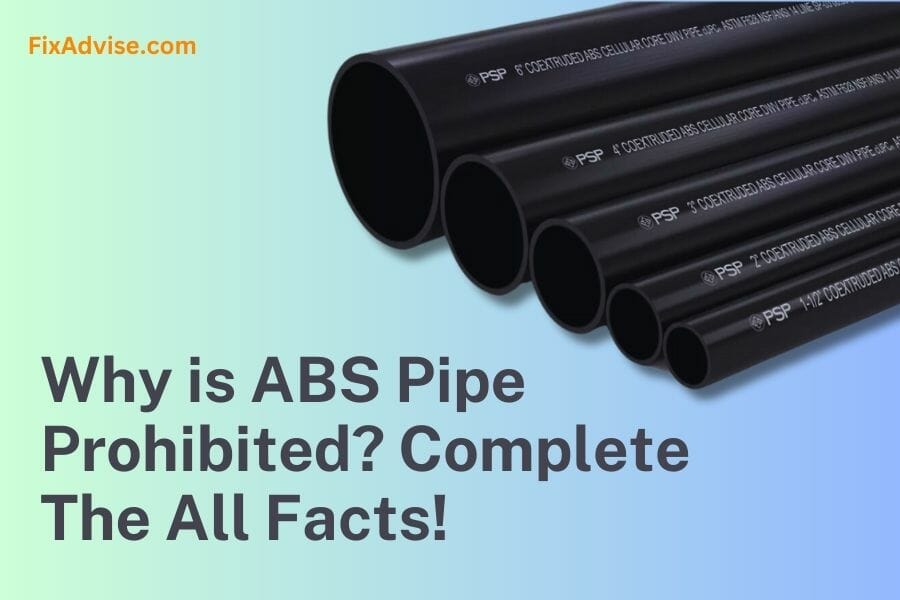Hey there, fellow homeowners and DIY enthusiasts! Today, I want to shed some light on a topic that often goes unnoticed but holds great importance when it comes to plumbing: ABS pipe. You may have heard that ABS pipe is prohibited in certain situations, but do you know why?
In this article, we’ll explore the reasons behind its prohibition, its advantages and disadvantages, its common uses, types of fittings available, whether it’s still used, what it’s made of, and alternative options. So, let’s dive right in and uncover the secrets of ABS pipe!
Why is ABS Pipe Prohibited?

ABS, short for Acrylonitrile Butadiene Styrene, is a type of plastic material commonly used in plumbing systems. However, it has been prohibited in some jurisdictions due to concerns over its performance and safety. One of the primary reasons is its vulnerability to heat. ABS pipe has a lower melting point compared to other types of pipes, which makes it more prone to warping or even melting when exposed to high temperatures. This can lead to leaks, structural failures, and potential fire hazards.
Moreover, ABS pipe is also known to be more susceptible to damage from exposure to sunlight and ultraviolet (UV) rays. Over time, this exposure can cause the pipe to become brittle and prone to cracking, compromising the integrity of the plumbing system.
ABS Pipe Advantages and Disadvantages
Like any material, ABS pipe has its own set of advantages and disadvantages. Understanding these can help us make informed decisions about its usage. Let’s take a closer look:
Advantages of ABS Pipe:
- Lightweight: ABS pipe is lightweight and easy to handle, making it convenient for installation and repairs.
- Chemical Resistance: It exhibits good resistance to many chemicals commonly found in plumbing systems, making it suitable for various applications.
- Sound Insulation: ABS pipe possesses excellent sound insulation properties, reducing noise transmission within the plumbing system.
Disadvantages of ABS Pipe:
- Heat Vulnerability: As mentioned earlier, ABS pipe is highly susceptible to damage from high temperatures, limiting its use in certain applications, such as hot water supply lines.
- UV Degradation: Prolonged exposure to sunlight and UV rays can cause ABS pipe to deteriorate, leading to potential leaks and failures.
- Limited Pressure Rating: ABS pipe has a lower pressure rating compared to other materials like PVC, restricting its use in high-pressure applications.
What is ABS Pipe Used For?
ABS pipe finds its application in various plumbing systems, both residential and commercial. Some common uses include:
- Drainage Systems: ABS pipe is commonly used for carrying wastewater from sinks, toilets, showers, and other plumbing fixtures to the main sewage line.
- Ventilation Systems: It is also utilized for venting plumbing systems, allowing proper air circulation to prevent vacuum and siphoning effects.
- Non-Pressure Applications: ABS pipe is suitable for applications where there is no significant pressure, such as in low-pressure irrigation systems or certain industrial processes.
ABS Pipe Fittings
When working with ABS pipe, it’s essential to have the right fittings to ensure a secure and leak-free connection. Various types of fittings are available specifically designed for ABS pipe, including:
- Couplings: Used to join two ABS pipes together.
- Elbows: Used to change the direction of the pipe.
- Tees: Used to create a branch connection in the pipeline.
- Adapters: Used to connect ABS pipe to other materials like PVC or copper.
Types of ABS Pipe
ABS pipe is available in different types based on its dimensions and applications. Common types include:
- Schedule 40 ABS Pipe: This is the standard thickness for ABS pipe and is commonly used in drainage and ventilation systems.
- Schedule 80 ABS Pipe: With a thicker wall, this type of ABS pipe is suitable for applications requiring higher pressure resistance, such as industrial processes.
Frequently Asked Question
Is ABS Pipe Still Used?
While ABS pipe has been prohibited in some areas, it is important to note that it may still be allowed and used in other jurisdictions for certain
applications. However, the overall trend is moving towards alternative materials that offer improved performance, durability, and safety.
What is ABS Pipe Made Of?
ABS pipe is made from a combination of three primary monomers: acrylonitrile, butadiene, and styrene. These monomers are polymerized to form a rigid thermoplastic material with excellent impact resistance and strength.
Is ABS plumbing bad?
ABS plumbing is not inherently bad, but it does have certain limitations and considerations to keep in mind. ABS pipe is known for its lightweight nature and resistance to many chemicals commonly found in plumbing systems. However, it is more vulnerable to heat and UV degradation compared to other materials like PVC.
This means that ABS plumbing may not be suitable for high-temperature applications or prolonged exposure to sunlight. Additionally, ABS pipes can become brittle over time, potentially leading to cracks or leaks. Therefore, it’s essential to assess the specific requirements of your plumbing project and consider alternative materials if necessary.
Which is better, ABS or PVC pipe?
The choice between ABS and PVC pipe depends on the specific needs and requirements of your plumbing project. Both materials have their advantages and disadvantages. PVC (Polyvinyl Chloride) is more durable, has a higher pressure rating, and is less prone to UV degradation compared to ABS.
Is ABS stronger than PVC?
When it comes to strength, PVC (Polyvinyl Chloride) tends to be stronger than ABS (Acrylonitrile Butadiene Styrene). PVC pipes have a higher pressure rating and are more rigid, making them suitable for applications where strength and pressure resistance are important factors. ABS, on the other hand, is more flexible and may be prone to warping or distortion under high pressure or heat.
Conclusion
Now that we’ve unraveled the mysteries behind ABS pipe, it’s clear why it is prohibited in certain situations. While ABS pipe does offer some advantages, its vulnerabilities to heat and UV degradation raise concerns about its long-term reliability and safety. As the plumbing industry evolves, alternative materials like PVC, CPVC, and PEX have emerged, providing enhanced performance and durability.
